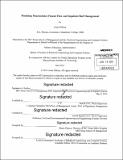| dc.contributor.advisor | Retsef Levi and David Simchi-Levi. | en_US |
| dc.contributor.author | Hiltrop, Jonas | en_US |
| dc.contributor.other | Leaders for Global Operations Program. | en_US |
| dc.coverage.spatial | n-us-ma | en_US |
| dc.date.accessioned | 2014-10-08T15:28:00Z | |
| dc.date.available | 2014-10-08T15:28:00Z | |
| dc.date.copyright | 2014 | en_US |
| dc.date.issued | 2014 | en_US |
| dc.identifier.uri | http://hdl.handle.net/1721.1/90769 | |
| dc.description | Thesis: M.B.A., Massachusetts Institute of Technology, Sloan School of Management, 2014. In conjunction with the Leaders for Global Operations Program at MIT. | en_US |
| dc.description | Thesis: S.M., Massachusetts Institute of Technology, Department of Electrical Engineering and Computer Science, 2014. In conjunction with the Leaders for Global Operations Program at MIT. | en_US |
| dc.description | 15 | en_US |
| dc.description | Cataloged from PDF version of thesis. | en_US |
| dc.description | Includes bibliographical references (page 104). | en_US |
| dc.description.abstract | Massachusetts General Hospital (MGH) experiences consistently high demand for its more than 900 inpatient beds. On an average weekday, the hospital admits about 220 patients, with the emergency department (ED) and the operating rooms (OR) being the main sources of admissions. Given MGH's high occupancy rates, a comparable number of discharges have to occur daily, and the intraday time distributions of admissions and discharges have to be aligned in order to avoid long wait times for beds. The situation is complicated by the specialization of beds and the medical needs of patients, which place constraints on the possible bed-patient assignments. The hospital currently manages these processes using fairly manual and static approaches, and without clear prioritization rules. The timing of discharges is not aligned with the timing of new admissions, with discharges generally occurring later in the day. For this reason MGH experiences consistent bed capacity constraints, which may cause long wait times for patients, throughput limitations, disruptions in the ED and in the perioperative environment, and adverse clinical outcomes. This project develops a detailed patient flow simulation based on historical data from MGH. The model is focused on the neuroscience clinical specialties as a microcosm of the larger hospital since the neuroscience units (22 ICU beds and 64 floor beds) are directly affected by the hospital's important capacity issues (e.g., patient overflows into other units, ICU-to-floor transfer delays). We use the model to test the effectiveness of the following three interventions: 1. Assigning available inpatient beds to newly admitted patients adaptively on a just-in-time basis; 2. Discharging patients earlier in the day; 3. Reserving beds at inpatient rehabilitation facilities, thereby reducing the MGH length of stay by one or more days for patients who need these services after discharge from the hospital. Intervention effectiveness is measured using several performance metrics, including patient wait times for beds, bed utilization, and delays unrelated to bed availability, which capture the efficiency of bed usage. We find that the simulation model captures the current state of the neuroscience services in terms of intraday wait times, and that all modeled interventions lead to significant wait time reductions for patients in the ED and in the perioperative environment. Just-in-time bed assignments reduce average wait times for patients transferring to the neuroscience floor and ICU beds by up to 35% and 48%, respectively, at current throughput levels. Discharges earlier in the day and multi-day length of stay reductions (i.e., interventions 2 and 3) lead to smaller wait time reductions. However, multi-day length of stay reductions decrease bed utilization by up to 4% under our assumptions, and create capacity for throughput increases. Considering the expected cost of implementing these interventions and the reductions in patient wait times, we recommend adopting just-in-time bed assignments to address some of the existing capacity issues. Our simulation shows that this intervention can be combined effectively with earlier discharges and multi-day length of stay reductions at a later point in order to reduce wait times even further. | en_US |
| dc.description.statementofresponsibility | by Jonas Hiltrop. | en_US |
| dc.format.extent | 122 pages | en_US |
| dc.language.iso | eng | en_US |
| dc.publisher | Massachusetts Institute of Technology | en_US |
| dc.rights | M.I.T. theses are protected by copyright. They may be viewed from this source for any purpose, but reproduction or distribution in any format is prohibited without written permission. See provided URL for inquiries about permission. | en_US |
| dc.rights.uri | http://dspace.mit.edu/handle/1721.1/7582 | en_US |
| dc.subject | Sloan School of Management. | en_US |
| dc.subject | Electrical Engineering and Computer Science. | en_US |
| dc.subject | Leaders for Global Operations Program. | en_US |
| dc.title | Modeling neuroscience patient flow and inpatient bed management | en_US |
| dc.type | Thesis | en_US |
| dc.description.degree | M.B.A. | en_US |
| dc.description.degree | S.M. | en_US |
| dc.contributor.department | Leaders for Global Operations Program at MIT | en_US |
| dc.contributor.department | Massachusetts Institute of Technology. Department of Electrical Engineering and Computer Science | |
| dc.contributor.department | Sloan School of Management | |
| dc.identifier.oclc | 891387996 | en_US |
